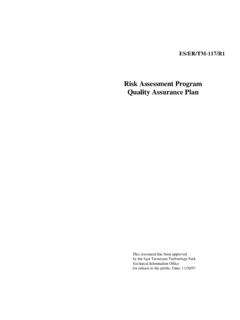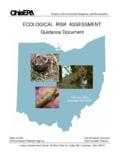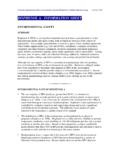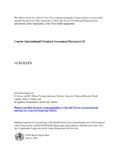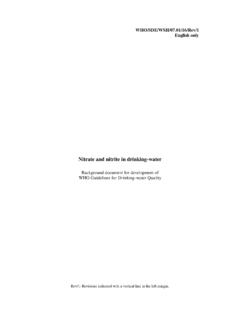Transcription of Dioxin Toxicity Equivalency Factors (TEFs) for …
1 -EPA/100/R 10/005 | December 2010 Recommended Toxicity Equivalence Factors (TEFs) for human health Risk Assessments of 2,3,7,8-Tetrachlorodibenzo-p- Dioxin and Dioxin -Like Compounds Office of the Science Advisor Risk Assessment Forum EPA/100/R-10/005 December 2010 Recommended Toxicity Equivalence Factors (TEFs) for human health Risk Assessments of 2,3,7,8-Tetrachlorodibenzo-p- Dioxin and Dioxin -Like Compounds Risk Assessment Forum Environmental Protection Agency Washington, DC 20460 NOTICE This report has been subjected to the Agency s peer and administrative review and has been approved for publication as an EPA document. Mention of trade names or commercial products does not constitute endorsement or recommendation for use. ABSTRACT This document describes the Environmental Protection Agency s (EPA s) updated approach for evaluating the human health risks from exposures to environmental media containing Dioxin -like compounds (DLCs).
2 2,3,7,8-tetrachlorodibenzo-p- Dioxin (TCDD) and DLCs are structurally and toxicologically related halogenated aromatic hydrocarbons. The EPA recommends that the Toxicity equivalence factor (TEF) methodology, a component mixture method, be used to evaluate human health risks posed by these mixtures, using TCDD as the index chemical. The EPA recommends the use of the consensus TEF values for TCDD and the DLCs published in 2005 by the World health Organization. EPA Program Offices and Regions have historically used TEF values in their risk assessments; this document recommends the 2005 WHO consensus TEFs, but does not address specific risk assessment applications of TEFs. The EPA recommends these TEFs be used for all effects mediated through aryl hydrocarbon receptor binding by the DLCs including cancer and noncancer effects. Using information that summarizes the range of relative toxicities of the DLCs, the EPA recommends that, for major risk assessments as determined by EPA Program Offices or Regions, the conduct of a sensitivity analysis be considered to illustrate the impact the TEFs have on the Toxicity equivalence (TEQ) value.
3 The EPA will update all of these recommendations in the future based on the evaluation of new Toxicity data for the DLCs, updates to available relative potency (ReP) data, including statistical summaries of RePs for individual DLCs, and the results of new consensus processes undertaken to update the TEF approach. Preferred citation: EPA (Environmental Protection Agency). (2010) Recommended Toxicity Equivalence Factors (TEFs) for human health Risk Assessments of 2,3,7,8-Tetrachlorodibenzo-p- Dioxin and Dioxin -Like Compounds. Risk Assessment Forum, Washington, DC. EPA/600/R-10/005. ii iii TABLE OF CONTENTS Page LIST OF TABLES .. iv LIST OF ABBREVIATIONS ..v LIST OF ABBREVIATIONS OF DIOXINS AND Dioxin -LIKE COMPOUNDS .. vi KEY TERMS .. vii PREFACE .. viii AUTHORS, TECHNICAL PANEL, AND REVIEWERS .. ix INTRODUCTION ..1 THE TEF BACKGROUND ..4 UNCERTAINTIES IN THE TEF UNCERTAINTY IN TEF METHOD ASSUMPTIONS.
4 10 UNCERTAINTY IN THE PROCESSES AND DATA USED TO DERIVE TEFs .. 11 RECOMMENDATIONS ..12 SENSITIVITY ANALYSIS .. 15 SENSITIVITY ANALYSIS 17 REFERENCES ..25 LIST OF TABLES No. Title Page 1. Background and history of TEFs for risk assessment of 5 2. Recommended Toxicity equivalence Factors (TEFs) for human health risk assessment of polychlorinated dibenzo-p- dioxins, dibenzofurans, and Dioxin -like polychlorinated biphenyls .. 13 3. Percentiles of in vivo ReP 18 4. Percentiles of combined in vivo and in vitro ReP values .. 20 5. Summary of risk characterization recommendations for TEF 24 iv LIST OF ABBREVIATIONS AhR aryl hydrocarbon receptor DLC Dioxin -like compound ECEH European Centre for Environmental health ED50 effective dose that causes an effect in 50% of the test units IPCS International Programme on Chemical Safety NAS National Academy of Science ReP relative potency or relative effect potency ReP1997 World health Organization ReP database developed in 1997 TCDD 2,3,7,8-tetrachlorodibenzo-p- Dioxin TEF Toxicity equivalence factor TEQ Toxicity equivalence EPA Environmental Protection Agency WHO World health Organization v LIST OF ABBREVIATIONS OF DIOXINS AND Dioxin -LIKE COMPOUNDS Polychlorinated biphenyls.
5 TCB tetrachlorinated biphenyl PeCB pentachlorinated biphenyl HxCB hexachlorinated biphenyl HpCB heptachlorinated biphenyl OCB octachlorinated biphenyl PCB polychlorinated biphenyl Polychlorinated dibenzo-p-dioxins: TCDD tetrachlorinated dibenzo-p- Dioxin PeCDD pentachlorinated dibenzo-p- Dioxin HxCDD hexachlorinated dibenzo-p- Dioxin HpCDD heptachlorinated dibenzo-p- Dioxin OCDD octachlorinated dibenzo-p- Dioxin PCDD polychlorinated dibenzo-p- Dioxin Polychlorinated dibenzofurans: TCDF tetrachlorinated dibenzofuran PeCDF pentachlorinated dibenzofuran HxCDF hexachlorinated dibenzofuran HpCDF heptachlorinated dibenzofuran OCDF octachlorinated dibenzofuran PCDF polychlorinated dibenzofuran vi KEY TERMS Dioxin -like: A description used for compounds that have chemical structures, physico-chemical properties, and toxic responses similar to 2,3,7,8-tetrachlorodibenzo-p- Dioxin (TCDD).
6 Because of their hydrophobic nature and resistance towards metabolism, these chemicals persist and bioaccumulate in fatty tissues of animals and humans. Certain members of the Dioxin , furan, and polychlorinated biphenyl (PCB) family are termed Dioxin -like in this document and are assigned toxic equivalence factor (TEF) values. Index Chemical: The chemical selected as the basis for standardization of Toxicity of components in a mixture. The index chemical must have a clearly defined dose-response relationship. For Dioxin like compounds (DLCs), TCDD is typically specified as the index chemical. (In some studies used to develop RePs, PCB126 has been used as the index chemical.) Relative Potency (ReP): The ratio of the potency of a compound to the standard toxicant in that specific study; a concept similar to toxic equivalence but based on a single study, species, or matrix, etc.
7 , and not integrated with other RePs to obtain a general TEF. Toxic Equivalence Factors (TEFs): TEFs are consensus estimates of compound-specific Toxicity /potency relative to the Toxicity /potency of an index chemical. TEFs are the result of expert scientific judgment using all of the available data and taking into account uncertainties in the available data. Toxic Equivalence (TEQ): TEQ is the product of the concentration of an individual DLC in an environmental mixture and its corresponding TCDD TEF for that compound. vii PREFACE This document updates the Environmental Protection Agency s (EPA s) approach for evaluating the human health risks from exposures to environmental media containing 2,3,7,8-tetrachlorodibenzo-p- Dioxin (TCDD) and Dioxin -like compounds (DLCs). It is intended for guidance only. It provides guidance to EPA Regional and Program Offices. EPA Program Offices and Regions have historically used TEF values in their risk assessments; this document recommends the 2005 WHO consensus TEFs, but does not address specific risk assessment applications of TEFs.
8 It does not establish any substantive rules under the Administrative Procedure Act or any other law and will have no binding effect on EPA or any regulated entity. Rather, it represents a statement of current policy. The EPA s National Center for Environmental Assessment developed the initial draft of this document, which was then reviewed and completed by a Technical Panel under the auspices of EPA s Risk Assessment Forum. EPA made the document available for public comment during a 30 day public comment period in September 2009, and an expert peer-review panel discussed the document in a teleconference open to the public on October 22, 2009. The public comments received by EPA were provided to the peer-review panel members prior to the October 2009 teleconference for their consideration in making comments and recommendations to EPA. The peer-review report, and EPA response to comments, is available at The Risk Assessment Forum was established to promote scientific consensus within EPA on difficult and controversial risk assessment issues and to ensure that this consensus is incorporated into appropriate risk assessment guidance.
9 To accomplish this, the Risk Assessment Forum assembles experts from throughout EPA in a formal process to study and report on these issues from an Agency-wide perspective. viii AUTHORS, TECHNICAL PANEL, AND REVIEWERS This document was prepared by authors from EPA s Office of Research and Development and was then reviewed and completed by a Technical Panel under the auspices of EPA s Risk Assessment Forum. AUTHORS Belinda Hawkins, EPA, Office of Research and Development, National Center for Environmental Assessment, Cincinnati, OH 45268 Janet Hess-Wilson, EPA, Office of Research and Development, National Center for Environmental Assessment, Cincinnati, OH 45268 Glenn Rice (Document Co-lead), EPA, Office of Research and Development, National Center for Environmental Assessment, Cincinnati, OH 45268 Jeff Swartout, EPA, Office of Research and Development, National Center for Environmental Assessment, Cincinnati, OH 45268 Linda K.
10 Teuschler (Document Co-lead), EPA, Office of Research and Development, National Center for Environmental Assessment, Cincinnati, OH 45268 TECHNICAL PANEL Randy Wentsel (Chair), EPA, Office of Research and Development, Office of the Assistant Administrator, Washington, DC 20460 Marlene Berg, EPA, Office of Solid Waste and Emergency Response, Office of Superfund Remediation Technology Innovation, Washington, DC 20460 David E. Cooper, EPA, Office of Solid Waste and Emergency Response, Office of Superfund Remediation Technology Innovation, Washington, DC 20460 Michael DeVito, National Institute of Environmental health Sciences, National Institutes of health , Research Triangle Park, NC 27709 (formerly a member of Environmental Protection Agency, National health and Environmental Effects Research Laboratory) Tala Henry, EPA, Office of Prevention, Pesticides and Toxic Substances, Office of Pollution Prevention and Toxics, Risk Assessment Division, Washington, DC 20460 Margaret McDonough, EPA, Region 1, Boston, MA 02114 Marian Olsen, EPA, Region 2, New York, NY 10007 Glenn Rice, EPA, Office of Research and Development, National Center for Environmental Assessment, Cincinnati, OH 45268 Dan Stralka, EPA, Region 9, San Francisco, CA, 94105 Linda K.
